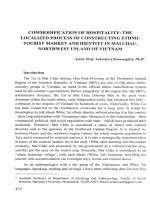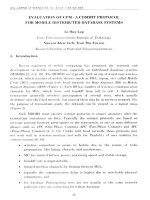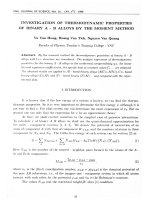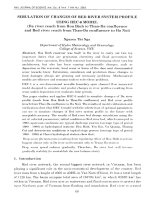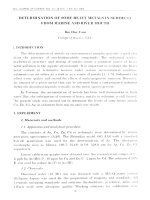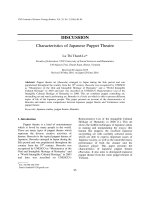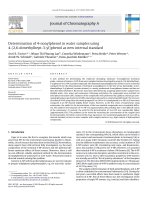DSpace at VNU: Determination of urinary phenolic metabolites from rats treated with 1,2,3-and 1,3,5-trimethylbenzenes
Bạn đang xem bản rút gọn của tài liệu. Xem và tải ngay bản đầy đủ của tài liệu tại đây (76.27 KB, 3 trang )
J Occup Health 2005; 47: 337–339
Short Communication
Determination of Urinary Phenolic
Metabolites from Rats Treated with 1,2,3- and
1,3,5- Trimethylbenzenes
Yuji TSUJIMOTO1, Munehiro WARASHINA1, Vu Duc NAM2,
Tsutomu N ODA 1 , Mitsuru SHIMIZU 1, Yukihiko Y AMAGUCHI 1,
Hiroshi MORIWAKI1, Tsumoru MORIMOTO3, Kiyomi KAKIUCHI3,
Yasuaki Maeda4 and Masanobu TANAKA1
Key words: Trimethylbenzene, Ring oxidation, Phenolic
metabolite
1
Osaka City Institute of Public Health and Environmental
Sciences, 2Vietnam National University, Hanoi, University of
Science, Research Center for Environmental Technology and
Sustainable Development, 3Graduate School of Materials
Science, Nara Institute of Science and Technology and
4
Department of Applied Materials Science, Osaka Prefecture
University, Japan
Trimethylbenzene (TMB) is widely used as a solvent
in the print and paint industries1), and for products such
as paint and varnish2). Hence it causes environmental
contamination not only in work places1) but also inside
houses3, 4). Toluene and xylene are regarded as ‘safe
replacements’ for benzene 5), due to the well-known
finding6) that these less methyl-substituted benzenes are
oxidized principally at a methyl substituent without
substantial aromatic ring oxidation during in vivo
metabolism. Although toxicological data on TMB are
not abundant, some critical toxicities have been reported
such as genotoxicity of TMB7, 8) and haematotoxicity of
1,2,3-TMB9). These data strongly suggest that TMB has
‘benzene-like’ toxicities. It is therefore necessary to
obtain information10) on ring oxidation during metabolism
of TMB. We describe here urinary excretion of phenolic
metabolites in rats administered 1,2,3- and 1,3,5-TMBs,
as a first investigation on ring oxidative metabolism of
TMB.
Materials and Methods
3,4,5- and 2,4,6-trimethylphenols (TMPs) were
purchased from Wako Chemicals Inc. (Kyoto, Japan).
2,3,4-TMP was synthesized according to the previously
reported method11). Naphthalene-d8 and acenaphthened10 for GC/MS were obtained from CIL (Cambridge
Received Feb 1, 2005; Accepted May 11, 2005
Correspondence to: Y. Tsujimoto, Osaka City Institute of Public
Health and Environmental Sciences, 8–34 Tojo-cho, Tennoji-ku,
Osaka 543-0026, Japan
(e-mail: )
Isotope Laboratory, England) and β-glucuronidase/aryl
sulphatase (EC 3.2.1.31, H-2, extract of Helix pomatia)
was obtained from Sigma Co (St.Louis, MO, USA). All
other chemicals were of special or analytical reagent
grade.
Male Wistar rats (7 weeks old; SLC, Hamamatsu,
Japan) were housed in individual stainless steel
metabolism cages with free access to water and food.
1,2,3- or 1,3,5-TMB was given intraperitoneally in doses
of 0.3, 1 and 3 mmol per kg of weight (administered in
2.5 ml of olive oil per kg of body weight). Rats receiving
an olive oil only served as a control group. Four rats
were used in each TMB treatment group as well as the
control group. Urine samples were collected daily for 2
days and stored at –20°C until the analysis.
Urine samples were hydrolyzed enzymatically using
an extract of Helix pomatia ( β -glucuronidase/aryl
sulphatase mixture) according to the previously reported
method10). Extraction and GC-MS determination of the
TMPs were carried out from the hydrolyzates similarly
as previously described12) for the analysis of urinary 3,4dimethylphenol. The recovery of each TMP was
satisfactory when 50 µg of it was added to 0.5 ml of a
hydrolyzed control urine sample (109.8 ± 11.3% for 2,3,4TMP, 103.7 ± 10.6% for 3,4,5-TMP and 118.8 ± 9.1%
for 2,4,6-TMP: n=5).
Results and Discussion
The target phenolic metabolites were 2,3,4- and 3,4,5TMPs from 1,2,3-TMB, and 2,4,6-TMP from 1,3,5-TMB
(Fig 1). As the objective of this preliminary study is to
show the extent of urinary phenolic metabolites excretion
from the TMBs, the determination of urinary TMPs were
undertaken using hydrolyzed urine samples. Urinary
excretion of these TMPs in the 48 h after dosage of the
TMBs is summarized in Table 1. The cumulative
excretion was approximately 5–10% of the administered
dose, with the excretion occurring mostly in the first 24
h after the treatment. 2,3,4-TMP was found to be the
main phenolic metabolite in 1,2,3-TMB and the excretion
of another isomer 3,4,5-TMP was very minor (<0.3% of
dose). The excretion (% of dose) of phenolic metabolites
decreased with increasing dose of 1,3,5-TMB, while this
trend was not observed in 1,2,3-TMB treated rats. The
degree of urinary excretion of the TMPs in 1,2,3-and
1,3,5-TMBs was close to that reported for 1,2,4-TMB10).
Toluene and xylene are metabolized almost exclusively
via the hippuric acid pathway6), although mercapturic acid
metabolism is also involved to a considerable degree
following an initial side chain oxidation in o-xylene13).
It was therefore assumed that toluene and xylene are ‘safe
replacements’ for benzene5). The urinary excretion of
phenolic metabolites is very limited in the metabolism
of these less methyl-substituted benzenes in vivo. Bakke
and Scheline14) reported 0.1–1.1% of dose for excretion
J Occup Health, Vol. 47, 2005
338
Fig. 1. Phenolic metabolites from 1,2,3- and 1,3,5-TMBs.
Table 1. Urinary excretion (% of dose)a) of the TMPs in 1,2,3- and 1,3,5-TMB treated rats
<1,2,3-TMB>
dose
mmol/kg
0.3
1.0
3.0
2,3,4-TMP
0–24 h
5.90 ± 2.62
7.93 ± 5.00
6.20 ± 3.45
3,4,5-TMP
24–48 h
total
0–24 h
24–48 h
total
0.46 ± 0.34
0.35 ± 0.16
0.57 ± 0.34
6.36 ± 2.92
8.28 ± 4.85
6.77 ± 3.60
ND
≤0.24
≤0.19
ND
ND
≤0.04
ND
≤0.24
≤0.19
<1,3,5-TMB>
dose
mmol/kg
0.3
1.0
3.0
2,4,6-TMP
0–24 h
7.04 ± 1.24
4.39 ± 0.61
3.32 ± 0.58
24–48 h
total
0.53 ± 0.29
0.51 ± 0.12
0.82 ± 0.34
7.57 ± 0.99
4.90 ± 0.64
4.14 ± 0.67
a) Each figure represents Mean ± SD for four rats or highest value in four rats (3,4,5-TMP).
of urinary methyl or dimethylphenols from rats
ˇ
administered toluene or xylene. Sedivec
and Flek15) found
that ring hydroxylated metabolites excreted in urine
corresponded to 0.05–1.98% of a dose administered to
volunteers exposed to isomeric xylenes. Contrary to this,
the present study as well as another investigation10) on
1,2,4-TMB indicate that the degree of phenolic metabolite
excretion from TMB is at least one order of magnitude
higher than those reported for toluene and xylene.
The higher excretion of phenolic metabolites from in
vivo metabolism of TMB is to be noted, especially in
relation to the genotoxicity of TMB 7, 8) and the
haematotoxicity of 1,2,3-TMB 9) previously reported.
Toluene and xylene have been shown 16) not to elicit
genotoxic action. There is no report on the
haematotoxicity of toluene and xylene, to our knowledge.
TMB may be regarded as a ‘benzene-like’ compound
because its reported toxicities are known to be
characteristic17) of benzene. Although the higher excretion
of phenolic metabolites may suggest the easier oxidation
of the aromatic ring, these toxicities cannot be directly
explained in terms of the quantitiy of phenolic
metabolites. Further research is needed to elucidate the
ring oxidative metabolism of TMB and to clarify its
Yuji TSUJIMOTO et al.: Phenolic Metabolites from 1,2,3- and 1,3,5- Trimethylbenzenes
relation to such toxicities.
References
1)
2)
3)
4)
5)
6)
7)
8)
9)
M Tanaka, T Kamiura, T Kawaraya and T Nakadoi:
Volatile aromatic C7-C9 hydrocarbon emissions from
some types of industrial painting, paint making and
printing processes. Environ Sci 5, 239–248 (1992)
Y Hanai, J Nakanishi, E Chin and J Nakanishi: Indoor
air pollution by building materials. Bull of Yokohama
National Univ Environ Sci Res Center 22, 1–10 (1996)
(in Japanese).
Ministry of Health and Welfare. Survey of volatile
organic compounds in indoor air of Japanese houses.
Press release document 1999 Dec 14 (in Japanese).
R Kostiainen: Volatile organic compounds in the indoor
air of normal and sick houses. Atomos Environ 29,
693–702 (1995)
R Van Doorn, RP Bos, RME Brouns, C Leijdekkers
and P Hendreson: Effect of toluene and xylenes on
liver gluthathione and their urinary excretion as
mercapturic acids in the rat. Arch Toxicol 43, 293–304
(1980)
˚
˚
R Toftgard
and J-A
Gustafsson: Biotransformation of
organic solvents (A review). Scand J Work Environ
Health 6, 1–18 (1980)
E J a n i k - S p i e c h o w i c z , K Wy s z y n s k a a n d E
Dziubaltowska: Genetoxicity evaluation of
trimethylbenzenes. Mutation Res 412, 299–305 (1998)
Ministry of Health and Welfare. Results of safety check
on high production volume chemicals (abstract ver in
FY 1994) 1997; 20–22 & 54–58 (in Japanese).
Z Korsak, J Stetkiewicz, W Majcherek, I Stetkiewicz,
10)
11)
12)
13)
14)
15)
16)
17)
339
J Jajte and K Rydzynski: Subchronic inhalation toxicity
of 1,2,3-trimethylbenzene(hemimellitene) in rats. Int
J Occup Med Environ Health 13, 223–232 (2000)
J-Z Huo, S Aldous, K Campella and N Davies:
Distribution and metabolism of 1,2,4trimethylbenzene(pseudocumene) in the rat.
Xenobiotica 19, 161–170 (1989)
BD MacKenzie, MM Angelo and J Wolinsky:
Acylation-cycloalkylation. A new annelation route to
Eudesmanes. J Org Chem 44, 4042–4046 (1979)
H Moriwaki, Y Tsujimoto, M Shimizu, T Noda, M
Warashina and M Tanaka: Influence of sodium
benzoate on the metabolism of o-xylene in the rat.
Xenobiotica, in press.
Tanaka M, Noda T, Shimizu M, Tsujimoto Y. In:
Ambrosi L, Soleo L, Ghittori S, Maestri L, Imbriani
M, eds. Mercapturic acids as biomarkers of exposure
to industrial chemicals. Maugeri Foundation Books
2001, Pavia. P, 155–160.
OM Bakke and RS Scheline: Hydroxylation of aromatic
hydrocarbons in the rat. Toxicol Appl Pharmacol 16,
691–700 (1970)
ˇ
Sedivec
V and Flek J: The Absorption, metabolism,
and excretion of xylenols in man. Int Arch Occup
Environ Health 37, 205–217 (1976)
RP Bos, RME Brouns, R van Doorn, JLG Theuws and
PTh Henderson. Non-mutagenicity of toluene, o-, m-,
and p-xylene, o-methylbenzylalcohol and omethylbenzylsulfate in the Ames assay. Mutation Res
88, 273–279 (1981)
R Snyder: Overview of the toxicology of benzene. J
Toxicol Environ Health A61, 339–346 (2000)

